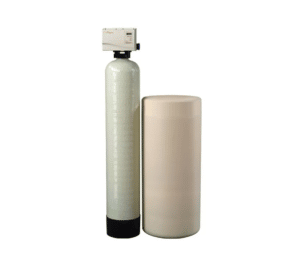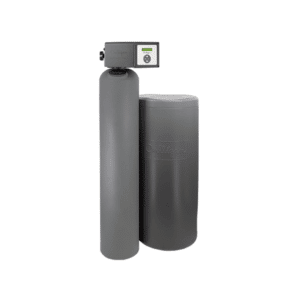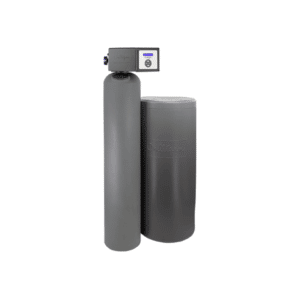Culligan is a household name in the water treatment industry. They’ve been in business since 1936, and have produced everything from water dispensers to whole-house reverse osmosis filtration systems. But what interests us today is their range of water softeners, which we’ll review in details.
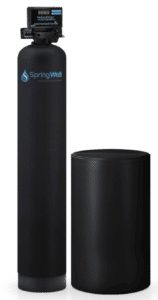
- Type: Ion Exchange
- Grain Capacity: 32,000 – 80,000 grains
- Flow Rate: 11 – 20 GPM
- Warranty: Lifetime
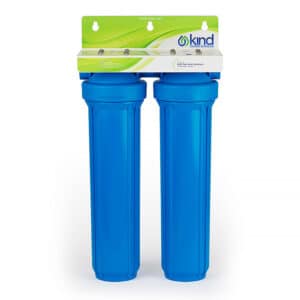
- Type: Template Assisted Crystallization
- Grain Capacity: N/A
- Flow Rate: 15 GPM
- Warranty: Lifetime
Culligan Water Softeners
Culligan water softener is split into 3 series:
Each series has 4 water softener models with similarities and differences.
For example, as a quality-of-life feature, all of the Culligan water softeners come with non-corrosive valves. Non-corrosive valves are very important for water softeners due to the risk of rusting because of the massive amounts of mineral-rich water that flows through the system on a daily basis.
1. Culligan Medallist Series
The Medallist series offers NSF-certified water softeners that are easy to use, simple to regulate and come with adjustable water pressure. All of the Medallist models also come with a metered regeneration cycle that saves water by only starting the process when a set amount of water has been softened, making them economical to use as well.
Water softener prices and dimensions usually reflect the amount of GPG (grams per gallon) that they’re expected to soften, as well as the flow rate they can achieve. In simple terms, the bigger and more expensive the water softener is, the bigger the max water hardness that it can handle.
The most distinguishing characteristic of the medalist models is that they’re less powerful than models in the HE or Smart series.
While this might seem like a drawback rather than a benefit, the truth is that most households don’t actually need water softeners that are all that powerful. If you live in the city and you don’t have water that’s particularly rich in minerals, then you can probably get a lot more use out of a smaller water softener than a larger model.
However, if you’re looking for something more powerful, then you’ll be pleased to know that there are also Medallist models that are capable of handling up to 99 GPG (grams per gallon) of hard minerals and producing flow rates of up to 10.0 GPM (Gallons per minute), which is ideal for households of 4-8 people.
This puts the bigger Medallist models nearly on par with the more powerful HE and Smart water softeners from Culligan.
| 8” Model | 30 Model | 45 Model | 60 Model | |
|---|---|---|---|---|
| Max Hardness | 75 GPG | 75 GPG | 99 GPG | 99 GPG |
| Regeneration Water Consumption | 23.3 gallons | 36 gallons | 46 gallons | 51 gallons |
| Regeneration Time | 85 minutes | 64 minutes | 64 minutes | 52 minutes |
| Flow Rate | 5.9 GPM | 9.0 GPM | 9.4 GPM | 10.0 GPM |
2. Culligan High-Efficiency Series
The HE series offers everything that models from the Medallist series do, but these models have a bit more power behind them.
As you may have noticed by the comparison charts, all of the HE models have a better flow rate than the Medallion models, which makes them a better option for larger households with 6 – 12 people.
However, they also use a lot more water per regeneration cycle than the Medallion series, and they either have the same max water hardness levels, or Culligan simply didn’t bother to record GPG past 99.
On the technical side of things, the HE models are incredibly easy to use, and they come with an LCD display that’s located on top of the resin tank. The settings are easy to understand and program. As a bonus, these models come with a sodium alarm that goes off whenever the brine tank needs to be refilled with salt, which is very convenient.
| 9″ Model | 10″ Model | 12″ Model | 14″ Model | |
|---|---|---|---|---|
| Max Hardness | 75 GPG | 99 GPG | 99 GPG | 99 GPG |
| Regeneration Water Consumption | 47 gallons | 60 gallons | 124 gallons | 167 gallons |
| Regeneration Time | 78 minutes | 67 minutes | 62 minutes | 76 minutes |
| Flow Rate | 9.0 GPM | 9.4 GPM | 10.0 GPM | 10.6 GPM |
3. Smart Series
The main difference between the Smart Series and the other two is the Culligan Connect App that these models come with. This phone app allows you to monitor all of the vital info on your water softener from anywhere as long as you have a wifi connection.
It allows you to check how much water and salt gets used up per regeneration cycle, it notifies you when the salt levels in your system are low and need replacing, and it allows you to turn the device on and off remotely.
The app also allows you to make pressure adjustments and change the regeneration settings as well. This will allow you to set the amount of water that can pass through the system before the regeneration cycle automatically starts.
Just keep in mind that there are several pre-programmed limits. While you can choose between them, you cannot input your own custom regeneration limits. This is mostly a failsafe feature to ensure that you don’t accidentally set the regeneration cycles too far apart and dry out the resin beads inside the tank.
| 9” Outdoor | 10″ Outdoor | 12″ Outdoor | 14″ Outdoor | |
|---|---|---|---|---|
| Max Hardness | 75 GPG | 99 GPG | 99 GPG | 99 GPG |
| Regeneration Water Consumption | 56 gallons | 82 gallons | 102 gallons | 167 gallons |
| Regeneration Time | 59 minutes | 77 minutes | 77 minutes | 77 minutes |
| Flow Rate | 10.9 GPM | 11.0 GPM | 12.6 GPM | 12.8 GPM |
Twin Tank Models
While these aren’t explicitly categorized as their own models, it still bears mentioning that Culligan also offers twin tank versions of both their High-Efficiency models and their Smart models.
These twin tank versions come with the same features and capabilities as the original models, down to the same GPG and GPM, but they’re geared much more towards larger households of apartment complexes.
This is thanks to how the two tanks interact with the brine tank. Single tank units need to pause their water softening while the regeneration process is underway in order to replenish the resin inside the tank. This is usually done by the water softening being stopped entirely during the regeneration process. Some models still work even while the regeneration is happening, but that results in you getting a glass full of brine water.
Single tank units require around an hour of downtime for the regeneration process, during which they’re effectively inoperational. This isn’t much of an issue since most people simply set the regeneration to run while they’re asleep.
Twin tank units get around this issue by simply switching the water softening process to the other tank. This means that tank 1 can go through the regeneration process while tank 2 is still taking care of the water softening.
Getting rid of this downtime makes twin tank units a much better water softener choice for apartment buildings or large households with high water demand.
Of course, the additional tank also means that these units are more expensive as well, but since these are geared toward multiple families and apartments, the price shouldn’t be an issue when everyone chips in.
The Price of Culligan Water Softeners
Culligan water softeners costs between $500 – $5000, which is the standard water softener system price. The exact price of each culligan model/series/unit can only be obtained by scheduling a free water consultation meeting with the company.
Most water softener brands display their prices in one of two ways. The first method is one that companies like Springwell adopt. They show each unit’s individual price transparently, and you can even see the exact prices of all the additional pieces of equipment that you may choose to buy along with the unit.
Culligan, on the other hand, doesn’t show the prices of their water softener units. Instead, you need to request a quote, which makes it pretty hard to get even a general price estimate.
In fairness to Culligan, they’re far from the only company in the water treatment field that have adopted this method. In fact, the vast majority of water softener brands like Kinetico and RainSoft also do this. However, that doesn’t make it any less of a pain to get a sense of the price range of these water softeners as an interested buyer.
How to Get a Price Tag
You can get a quote by simply going to the main page on the Culligan site and clicking on the large orange “schedule free water consultation” CTA at the top of the page.
Once you get transferred to the consultation page, you’ll need to enter your name, address, state, postal code, email address, phone number, and any other information that will be requested of you.
Once all of this is done, pick an appointment on a day that works for you and send in the request. You should receive an email or a message on your phone telling you that the request has been confirmed or denied within a few days.
The Good and the Bad
This pricing method comes with certain issues, as well as advantages.
The advantage of getting a quote specifically for you is that you’ll know exactly how much the water softener will cost down to the dollar. All of the upfront purchase fees, transport expenses, and installation costs are included, and you’ll get a very accurate quote on everything from A-Z about getting one of these appliances into your home.
This is better than most water softener brands that list their prices openly but neglect to mention how much the additional costs, like the transport and installation, will set you back.
On the other hand, anyone that’s just researching different water softener models will likely lose interest in Culligan models due to this pricing method.
If you haven’t owned a Culligan model before, or you have no idea what the product is like, you’re more than likely not going to be interested enough to fill out so much information just to get an idea about the price.
That’s the other thing, the information. These quotes require a lot of personal information, and it’s understandable if you aren’t all too keen on leaving all of your personal data on some random site.
Worthy Culligan Water Softener Alternatives:
If you don’t want to go through the hassle of getting pricing from culligan, here are 2 high-quality culligan water softener alternatives you can get instead:
- Springwell SS1 Salt-Based Water Softener (also see Springwell Salt-free Softener)
- Kind Water Systems E-2000 Water Softener

- Type: Ion Exchange
- Grain Capacity: 32,000 – 80,000 grains
- Flow Rate: 11 – 20 GPM
- Warranty: Lifetime

- Type: Template Assisted Crystallization
- Grain Capacity: N/A
- Flow Rate: 15 GPM
- Warranty: Lifetime
Price, Technology & Customer Support Feedback
Price
As we’ve already mentioned, the price isn’t stated outright, so whether these softeners are considered cheap or expensive by industry standards is beyond us.
From what we could gather from users feedback, these particular units are pretty pricey, but whether that means that they’re $2,000 or $4,000, we can’t say. The problem is that while we don’t take single feedback all that seriously, this sentiment seems to be echoed by quite a few people.
Our opinion on this matter is undetermined. We’d suggest asking for a quote and finding out the exact prices of these devices before you make up your mind about them.
Technology
Water softeners aren’t devices that are particularly well-known for their robust features or world-shaking technology.
All you can really ask of appliances like these is that they’re easy to program, that they come with a sodium alarm, that they have an app, and maybe a surge protector. Certain Culligan models have ¾ of those features, which is pretty decent in our books.
It’s always nice when the settings are straightforward, the sodium alarm makes it so you don’t need to keep manually checking the brine tank, and we’ve already outlined the pros of the Culligan app.
In our opinion, the Culligan water softeners, and especially the Smart models, have just about everything that you might need from a water softener.
Customer Support
Culligan’s customer support leaves a lot to be desired. Busy phone lines, no replies to emails, and massive delays in repair schedules are all issues that have been brought up in numerous customer feedback.
Similar Water Softener Brands to Consider
Here are some high-quality water softener brands to also consider:
Final Thoughts
Taking all that we’ve outlined into account, our final opinion on Culligan is that they’re one of the most middle-of-the-road water softener companies on the market. We know that this may not be what you were hoping to hear, but it’s the truth.
Culligan water softeners are decently well-equipped, and you have at least a dozen models that you can pick from. On the other hand, they don’t have anything that makes them stand out from the competition, and the variety between their models is incredibly limited to the point where they all seem pretty similar.
We’d say that these water softeners are worth considering, and it’s worth it to try and get an accurate quote on them. Once you know how much they cost, then you can make up your mind on whether or not they’re worth it.
